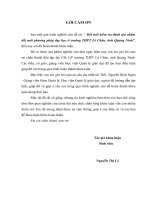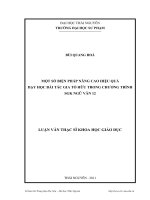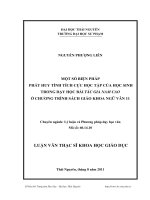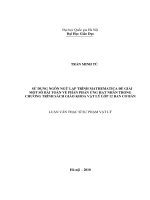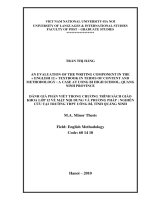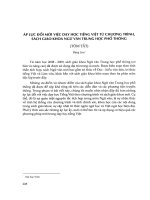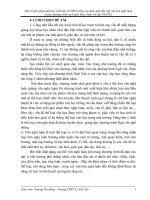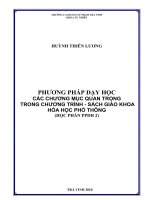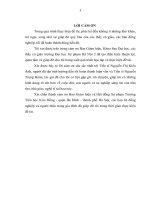Đánh giá phần viết trong chương trình sách giáo khoa lớp 12 về mặt nội dung và phương pháp nghiên cứu tại trường THPT Uông Bí, tỉnh Quảng Ninh
Bạn đang xem bản rút gọn của tài liệu. Xem và tải ngay bản đầy đủ của tài liệu tại đây (640.91 KB, 68 trang )
VIET NAM NATIONAL UNIVERSITY-HA NOI
UNIVERSITY OF LANGUAGES & INTERNATIONAL STUDIES
FACULTY OF POST – GRADUATE STUDIES
*****************
TRẦN THỊ HẰNG
AN EVALUATION OF THE WRITING COMPONENT IN THE
« ENGLISH 12 » TEXTBOOK IN TERMS OF CONTENT AND
METHODOLOGY : A CASE AT UONG BI HIGH SCHOOL, QUANG
NINH PROVINCE
ĐÁNH GIÁ PHẦN VIẾT TRONG CHƯƠNG TRÌNH SÁCH GIÁO
KHOA LỚP 12 VỀ MẶT NỘI DUNG VÀ PHƯƠNG PHÁP : NGHIÊN
CỨU TẠI TRƯỜNG THPT UÔNG BÍ, TỈNH QUẢNG NINH
M.A. Minor Thesis
Field: English Methodology
Code: 60 14 10
Hanoi – 2010
VIET NAM NATIONAL UNIVERSITY-HA NOI
UNIVERSITY OF LANGUAGES & INTERNATIONAL STUDIES
FACULTY OF POST – GRADUATE STUDIES
*****************
TRẦN THỊ HẰNG
AN EVALUATION OF THE WRITING COMPONENT IN THE
« ENGLISH 12 » TEXTBOOK IN TERMS OF CONTENT AND
METHODOLOGY : A CASE AT UONG BI HIGH SCHOOL, QUANG
NINH PROVINCE
ĐÁNH GIÁ PHẦN VIẾT TRONG CHƯƠNG TRÌNH SÁCH GIÁO
KHOA LỚP 12 VỀ MẶT NỘI DUNG VÀ PHƯƠNG PHÁP : NGHIÊN
CỨU TẠI TRƯỜNG THPT UÔNG BÍ, TỈNH QUẢNG NINH
MA. Minor Thesis
Field: English Methodology
Code: 60 14 10
Supervisor: Hoàng Xuân Hoa, Ph.D
Hanoi - 2010
iv
LIST OF ABBREVIATIONS
T: Teachers
S: Students
MOET: Ministry of Education and Training
v
LIST OF FIGURES AND TABLES
Figure 1: The materials evaluation model of Hutchinson and Waters ( 1993: 98)………. 9
Figure 2 : The process of writing ( Tribble, 1996: 38) 17
Table 3.1. Teacher’s rank of the students’ interest and students’ interest on MOET topics
(Q1)……………………………………………………………………………………… 26
Table 3.2: Students and teachers’ opinions about text types, tasks and activities
( Q2,3,4,5)…………………………………………………………………………………27
Table 3.3: The teachers and students’opinions about using four intergrated macro-skills in
the writing tasks ( Q6)…………………………………………………………………… 28
Table 3.4: Teachers and students’ opinions about the amount of knowledge given in
writing component. ( Q7)………………………………………………………………….28
Table 3.5: The students and teachers’ judgement on each part of the writing component in
the textbook. ( Q8)…………………………………………………………………………29
Table 3.6: Teachers and students’ suggestions on each part of the writing component.
( Q9) 31
Table 3.7: The teachers and student’s suggestions of tasks in the writing component
(Q8) 33
Table 3.8: Teachers’ opinion about the writing approaches used in the textbook
( Q11,12) 33
Table 3.9: Students’ opinions of the teaching methods used by the teachers during the
writing lessons.( Q13) 34
Table 3.10: Students’ expectations about the ways the English teachers’ teaching writing
Q14) 34
Table 3.11: Teachers and Students’opinions about kinds of tasks, exercises and guidance
in the writing component (Q 15,16)……………………………………………………….35
Table 3.12. Teachers and Students’s opinions of the interaction patterns in the class
( Q17)………………………………………………………………………………….… 35
vi
TABLE OF CONTENTS
CERTIFICATE OF ORIGINALITY OF THE THESIS…………………… ……… i
ACKNOWLEDGEMENTS…………………………………………………… … ii
ABSTRACT…………………………………………………………………… iii
LIST OF ABBREVIATIONS…………………………………………………………….iv
LIST OF TABLES……………………………………………………………… v
TABLES OF CONTENT…………………………………………………………………vi
PART I: INTRODUCTION………………………………………………………………1
1. Rationale of the study……………………………………………………………….1
2. Aims of the study………………………………………………………………… 2
3. Research questions………………………………………………………………… 2
4. Scope of the study………………………………………………………………… 2
5. Significance of the study………………………………………………………… 2
6. Method of the study……………………………………………………………… 3
7. Design of the study………………………………………………………… 3
PART II: DEVELOPMENT …………………………………………………………… 4
Chapter 1: Theoretical Background…………………………………… ……………….4
1.1. Teaching Materials in Language Teaching and Learning 4
1.1.1. The roles of Teaching Materials 4
1.1.2. Types of Materials 4
1.2. Materials Evaluation 5
1.2.1. The concepts of Materials Evaluation 5
1.2.2. The reasons for Materials Evaluation 6
1.2.3. Types of Materials Evaluation 6
1.2.4. Materials Evaluators 7
1.2.4.1 Materials Evaluation by Outsders 7
1.2.4.2 Materials Evaluation by Insiders 8
1.2.5 Models for Materials Evaluation 8
1.2.5.1. Evaluation model by Huchinson and Waters 8
1.2.5.2 Evaluation model by Ellis 9
1.2.5.3. Evaluation model by McDonough and Shaw 10
vii
1.2.6 Criteria for Materials Evaluation 11
Criteria defined by Hutchinson and Waters 11
1.3 Materials Adaptation 13
1.3.1 Reasons for adapting 13
1.3.2 Adapting techniques 13
1.3.2.1 Adding 13
1.3.2.2 Deleting or Omitting 14
1.3.2.3 Modifying 14
1.3.2.4 Simplifying 14
1.3.2.5 Re-ordering 14
1.4. Theoretical backgrounds to writing and teaching writing 14
1.4.1 Reasons for teaching writing 14
1.4.2 Main approaches to teaching writing 15
1.4.2.1 The product approach 15
1.4.2.2 The process approach 16
Chapter 2: The study…………………………………………………………………….18
2.1. Overview of the current situation of teaching and learning English writing
component at Uong Bi High School. ………………………………………………… 18
2.1.1. The school context ………………………………………………………….18
2.1.1.1. The teachers at Uong Bi high shool………………………………18
2.1.1.2. The learners at Uong Bi high school…………………………… 18
2.1.2. The new English textbook for grade 12 (Standard Textbook)…………… 18
2.1.3. The current teaching and learning of English 12 writing component at Uong
Bi High school 19
2.1.3.1.The opportunities of the context………………………………… 19
2.1.3.2. The constraints of the context 20
2.2. The study………………………………………………………………………… 21
2.2.1. Research questions………………………………………………………….21
2.2.2. Participants of the study ……………………………………………………21
2.2.2.1. The teachers………………………………………………………22
2.2.2.2. The students……………………………………………………….22
2.2.3. Data collection instrument………………………………………………… 22
viii
2.2.3.1. Document analysis……………………………………………… 22
2.2.3.2. Survey questionnaire……………………….…………………… 22
2.2.4. Data collection procedure………………………………………………… 23
Chapter 3: Results and discussions 25
3.1. Document Analysis 25
3.1.1. Description of the writing component of in the “English 12” 25
3.1.2. Requirements of the writing component of the course 25
3.2. The Survey Results 26
3.2.1 The appropriateness of the writing component to the content of the course 26
3.2.2 The appropriateness of the writing component in terms of
methodology 33
3.3 Major Findings 36
3.3.1. The suitability of the writing component in the English 12 textbook to the
requirements of the MOET 37
3.3.2. The suitability of the writing component to the students’needs in terms of
content and methodology 38
3.4.Suggestions for the improvement 38
PART III: CONCLUSION…………………………………………………………… 41
1. Conclusion of the study…………………………………………………………… 41
2. Limitations of the study………………………………………………………… 41
3. Suggestions for further study………………………………………………….……42
REFERENCES 43
APPENDIX 1: AN OVERVIEW OF THE WRITING COMPONENT IN THE ENGLISH 12
TEXTBOOK……………………………………………………………………………………………… I
APPENDIX 2: QUESTIONNAIRE FOR TEACHERS…………………………… II
APPENDIX 3: QUESTIONNAIRE FOR STUDENTS……………………………XIII
APPENDIX 4: QUESTIONNAIRE FOR STUDENTS ( Vietnamese version)…….XIV
1
PART I: INTRODUCTION
1. Rationale of the study
Nowadays English has become increasingly important as a means of global
communication and a bridge to mankind‟s knowledge. In the process of global integration,
the teaching and learning English has become a great concern in Vietnam. Therefore, the
government has changed the curriculum in order to train the citizens who can use English
for communicative purposes. By doing this, in 2002 the Ministry of Education and
Training (MOET) announced a new textbook project for upper secondary school level. The
new textbooks comprised two sets. Set 1, unofficially called “sách chuẩn” (i.e “standard
textbooks”, was intended for students pursuing Ban cơ bản (i.e. The non-specialization
program) and Ban tự nhiên (i.e. specialization in sciences). Set 2, unofficially called “Sách
nâng cao”(i.e. advanced textbooks), was intended for Ban xã hội (i.e. specialization in
social sciences and humanities). Each set comprised of three books, from English 10 to
English 12.
The new English textbooks for high school students are claimed to adopt the latest teaching
and learning approaches: communicative approach and learner-centered approach and aim
at developing both language skills and language knowledge for students. Each unit in the
new English textbooks consists of five parts: Reading, Speaking, Listening, Writing and
Language Focus.
English 10 and English 11 were approved and officially introduced into schools by MOET
in the academic years 2006-2007 and 2007-2008 respectively. However, English 12
textbook has only been used nationwide since the academic year 2008-2009. Therefore,
English 12 textbook is rather new to the students and teachers and little research has been
carried out to evaluate this textbook.
Uong Bi High school, one of the high schools in the country, adopted “standard textbooks”.
As a teacher of English, the researcher has worked quite closely with the new textbooks. It
is noticed that although the textbooks have shown a great deal of improvement compared
to the old series of grammar-based textbooks, the implementation of this textbook causes a
large number of difficulties, especially the writing component.
Evaluation of teaching materials is obviously a very important process in language
teaching and learning. The results from materials evaluation help to determine whether the
2
set of materials is suitable for a particular situation. Most often materials evaluation is
carried out to find out the strengths and weaknesses of the materials so that changes need
to be made to improve the suitability and enhance the effectiveness of the materials. This is
the reason why the researcher conducted an evaluation of the writing component in
“English 12” textbook.
2. Aims of the study
The study is aimed to evaluate the Writing component in “English 12” textbook at Uong Bi
secondary school in terms of content and methodology to determine whether it truly
reflects the objectives prescribed by MOET for the course and suitable to the students‟
needs of English. It is expected that the findings from the study would make contribution
to the improvement of the textbook or propose changes to enhance the effectiveness of the
material for the future use.
3. Research questions
The study is to find out the answers to the following research questions:
1. Does the writing component of the “English 12” textbook meet the requirements of
the course in terms of content and methodology?
2. Is the writing component of the “English 12” textbook suitable to the students‟
needs in terms of content and methodology?
4. Scope of the study
Though the author is aware that in order to have a comprehensive evaluation of any
material, a great number of criteria should be taken into consideration, such as the audience,
the content, the methodology, the cultural bias, the authenticity, the layout etc, and each
criterion needs taking into account various aspects. With the scope of this minor thesis, this
study is only aimed at evaluating the suitability of the writing component in English 12
textbook in the standard in terms of content and methodology.
This study is a in-depth survey at Uong Bi High School in Quang Ninh. Therefore, the
findings of the study are not intended to be generalized to other school contexts. Indeed the
findings may not apply beyond the actual participants in this particular study.
5. Significance of the study
The findings of the thesis will serve as a back- up for the improvements of the writing
component in the “English 12” textbook, teachers‟ method adjustment and materials
adaptation as well. Practically, the findings are beneficial for both teachers and learners at
3
Uong Bi High school from the experience of reflection. Secondly, the findings of the study
will contribute information to textbook writers and educators to determine curricula and
program direction. It is also hoped that the thesis will be of contributions towards the
development of the writing component in general and the writing component in “English
12” textbook in particular.
6. Method of the study
In order to evaluate the writing component of the „English 12‟ textbook, document analysis
and survey questionnaires were employed to address the two questions being investigated.
Document analysis was one of the main instruments with a thorough objective analysis of
the textbook under evaluation. Survey questionnaire was used to collect the data that
related to the teachers‟ and students‟ perspectives and attitudes towards the textbook they
have just finished. The findings are expected to provide convincing evidence for the
contribution to the improvement of the textbook for the future use.
7. Design of the study
The study consists of three parts: the introduction, the main content and the conclusion.
The introduction provides the basic information such as the rationale of the study, the aims,
the research questions, the scope, the significance of the study and the methods of the
study.
The main content is divided into 3 chapters. Chapter one reviews the literature on materials
evaluation. It first presents the roles and types of materials in language teaching. Then it
presents major issues in materials evaluation, including reasons for materials evaluation,
types of materials evaluation, who carries out and who provides data for materials
evaluations, models for materials evaluation and criteria for materials evaluation. Next it
provides the information about materials adaptation such as reasons for adapting and
adapting techniques. Finally, it focuses on theoretical backgrounds to writing and teaching
writing, which consists of reasons for teaching writing and main approaches to teaching
writing. This part plays an important role in the evaluation of the writing component in the
study. Chapter two focuses on the methodology employed in the study, including the
research questions, research method, data collection procedures and the participants.
Chapter three reports discussions of the results, the findings and the recommendations for
the improvement of the materials. The conclusion presents a review of the study, the
limitations and some suggestions for further research.
4
PART II: DEVELOPMENT
CHAPTER 1: THEORETICAL BACKGROUND
1.1. Teaching materials in language teaching and learning
Materials are used in all language teaching and their role in the process of language
teaching and learning is of great importance (Dudley – Evans & St. John, 1998; Richards,
2001). The role of teaching materials in language teaching will be discussed in more
details in the next part of this section.
1.1.1. The roles of teaching materials
Significant roles that teaching materials play in language teaching are discussed by
different authors in the literature. Richards and Rodgers (cited in Nunan, 1991) view
instructional materials as detailed specifications of content, and guidance to teachers on
both the intensity of coverage and the amount of attention demanded by particular content
or pedagogical tasks.
Richards and Rodgers‟ perspective is supported and clarified by Richards (2001), who
points out that teaching materials can serve as the basis for much of the language input that
the learners receive and as the source for much of the language practice that occurs in the
classroom. Richards further explains that materials provide basis for the content of the
lesson, the balance of skills taught, and the kind of language practice students take part in.
In addition, good teaching materials are of great help to inexperienced teachers and poorly
trained teachers (Nunan, 1991; Richards, 2001). They can serve as “ a form of teacher
training” (Richard, 2001: 251) and teachers can get ideas on how to plan and teach the
lesson from the materials.
Obviously, teaching materials are a key and crucial component in any language teaching
contexts, the teacher needs to take account of the roles as well as the requirements of
teaching materials when designing or selecting materials for his/ her own teaching situation
to facilitate the most learning from the students.
1.1.2. Types of materials
Materials in use can vary from a textbook, institutionally prepared materials or the
teacher‟s own materials (Richards, 2001). The former is referred to as published textbooks
and the latter in-house materials by Robinson (1991). Which one to choose, published
textbooks or in-house materials is what specialists in the field of English language teaching
5
(ELT) weigh up arguments. O‟Neill (cited in Robinson, 1991:58) suggests that no other
medium is as easy to use as a textbook. More important “ a textbook is complete not just in
the physical sense but in the sense that the whole term‟s or year‟s course is available to the
students at once”. However, Ewer and Boys (cited in Robinson, 1991) reject it in terms of
the validity of the linguistic contents, the accuracy of the explanations and examples given,
and the number and coverage of the exercises because the writers just focus on approach
and methodology. Moreover, as Swales (cited in Robinson, 1991:57) indicate published
textbooks are “less self- sufficient in practice materials and in coverage of skill areas” so
these textbooks need to be supplemented by some other materials.
There are also arguments for and against the use of in-house materials. On the one hand,
as Robinson (1991) suggests, there are three advantages of in-house materials. Firstly, in-
house materials are likely to be more specific and appropriate than published material and
to have greater face validity in terms of the language dealt with and the contexts it is
presented in. Secondly, in house materials may be more flexible than published textbooks.
Finally, the writers of in-house materials can make sure of the suitability of methodology
for the intended learners. On the other hand, Robinson (1991) points out making in-house
materials is time- consuming and expensive. What is worse is that many locally produced
materials “show a striking resemblance to the published materials that have been rejected”
(Swales, cited in Robinson, 1991: 58).
As a rule, there always two sides of one problem. And as it is always said that there is no
perfect textbook which fits all teaching- learning context. So, an evaluation of materials is
really important before a course book is chosen.
1.2. Materials Evaluation
1.2.1.The concepts of materials evaluation
There are many ways of defining evaluation. According to Brown (1995) evaluation is
defined as “ the systematic collection and analysis of all relevant information necessary to
promote the improvement of a curriculum and assess its effectiveness within the context of
the particular institution involved”. This definition requires that information be gathered
and analyzed in a systematic manner and that only relevant information should be included,
that is other information can be ignored.
Nunan (1988) suggests that evaluation be “a process not a final product” that means it
takes place at any time of the material design. The first and foremost emphasis of
6
evaluation is to determine whether the goals and objectives of a language program are
being attained.
According to Tom Hutchinson and Waters (1993) evaluation is really a matter of judging
the fitness of something for a particular purpose. “Given a certain need, and in the light of
the resources available, which out of number of possibilities can represent the best
solution? There is no absolute good or bad- only degrees of fitness for the required
purpose”.
From the above definitions, it can be inferred that materials evaluation involves the
determination of what needs to be evaluated, the objectives and requirements for the
materials, and the judgments of the value of the materials being evaluated in relation to the
objectives and requirements determined.
1.2.2. The reasons for materials evaluation
There are two main reasons for carrying out materials evaluation. Firstly, there may be a
need to choose among the materials available the most suitable ones to use for a particular
situation. Secondly, there can be a need for materials evaluation to determine whether the
material which has been chosen works for that situation after it has been used for a period
of time ( Ellis, 1997).
Robinson (1991) adds, evaluation can be used as part of quality control. Through
evaluation, we can know about the advantages and disadvantages as well as the
effectiveness of the being used materials. Then we can decide whether the materials can be
reused or whether it needs to be adapted to meet the need of the particular teaching
situation or we need to change it absolutely.
In short, the findings of materials evaluation will provide input for responsible people to
evaluate the effectiveness of the materials.
1.2.3. Types of materials evaluation
There are three types of evaluation according to the reasons for materials evaluation:
Preliminary evaluation, formative evaluation and summative evaluation.
Preliminary Evaluation
This types of evaluation is carried out before a course begins in order to select the most
suitable and relevant materials for a particular group of learners.
This also has the purpose of identifying which aspects of the published materials need to
be adapted to suit the purposes of the evaluators (Robinson, 1991; Ellis, cited in Tomlinson,
7
1993). This can be done by “determining a set of criteria which are used to reach a decision
regarding which book to adopt and how it needs to be adapted” ( Ellis, cited in Tomlinson,
1993: 220).
Formative Evaluation
This type is normally carried out during the life of a course project and the results obtained
can be used to modify what is being done. Or in other words, such results may suggest the
development of the materials in the future.
Summative Evaluation
Summative evaluation is referred to as evaluation as retrospective evaluation (Ellis, 1997).
It takes place at the end or sometimes after the course has been implemented and very
valuable for “durable course” (Dudley – Evans, 1998). According to Richards (2001), a
summative materials evaluation is conducted to determine whether the materials have
worked well. The findings will normally lead to the decision whether to repeat or use the
materials again or not: and which aspects of the materials need to be changed and how to
modify them to make the materials after they have been used. This kind of evaluation
therefore can serve as a means of “testing” the validity of a before- program evaluation and
it can point out “ways in which the predictive instruments can be improved for future use”
( Ellis, 1997: 37).
In short, whatever the types of evaluation, preliminary, formative, or summative are, it is
very important that the evaluator identifies clearly the reasons for their evaluation so that it
can be beneficial for the use of the materials (Robinson, 1991)
1.2.4. Materials evaluators
A great deal of published work on materials evaluation (Dudley – Evans & St. John, 1998;
Tomlinson, 1998; Robinson, 1991; Richards, 2001) reveals that materials evaluation can be
carried out by outsiders (those who are not involved in the program, for example,
consultants, inspectors, and adminstrators ) or insiders (e.g. teachers, students, course or
materials designers); each method has its own advantage as well as disadvantages.
1.2.4.1 Materials evaluation by outsiders
As many researchers think, the advantages of having outsiders involved in materials
evaluation are obvious. They can bring “ fresh” and “ objective” perspectives into the
evaluation. However, there may be some disadvantages; outsiders as evaluators will have
their own views on language teaching methods. They may not understand the teaching and
8
learning situation in which the evaluation is being carried out. So, as Robinson (1991)
suggests, they may be unsympathetic and it may take more time for them to get to know
the local situation such as learners‟ needs, facilities as well as constrainst. As a result, it
may be hard for them to make exact judgements and realistic recommendations; or may be
what they find has already been found ( Dudley- Evans & St. John, 1998).
1.2.4.2 Materials evaluation by insiders
Materials evaluation by insiders has some advantages especially if the overall purpose of
evaluation is for “ development” and thus for better use in the future. As they have already
involved in the program, they will understand the teaching and learning situation well
(Tomlinson, 1998). Tomlinson‟s view is strongly supported by Holliday (cited in Dudley –
Evans & St. John, 1998) and Richards (2001). According to Holliday (1998: 296), the
evaluator‟s understanding of “ cultural and political factors” of the institution in which the
evaluation takes place would be very important for the evaluator to make exact judgements
and realistic recommendations. Richards (2001) holds the view that the involvement of the
insider plays a very important role in the success of evaluation because “ as a consequence,
they will have a greater degree of commitment to acting on its results”. Richards also
points out insiders, especially teachers, can „ monitor‟ when the materials are being used,
they therefore can determine if and to what extent the materials „ work‟ for their purposes
and thus they can make modifications to improve the effectiveness of the materials.
However, the insiders “ may be too close and involved” (Dudley-Evans & St. John, 1998:
131) so the evaluation may be influenced by their teaching experience and their subjective
views.
In short, who will carry out the evaluation outsiders or insiders should be determined
according to the purposes of the evaluation and to the facilities as well as the constraints of
the situation in which the evaluation takes place.
1.2.5 Models for materials evaluation
There are different models for materials evaluation suggested by different authors in the
literature. The popular models are the ones suggested by Hutchinson and Waters (1993),
Ellis (1997) and McDonough and Shaw (1993).
1.2.5.1. Evaluation model by Huchinson and Waters
Hutchinson and Water (1997)‟s model is a macro- evaluation which as defined by Ellis
(1997:37) as the “overall assessment of whether an entire set of materials has worked” for
9
a particular situation. In their model, Hutchinson and Waters (1993: 96) defined materials
evaluation as a “matter of judging the fitness of something for a particular purpose”. In this
view, the evaluation is divided into 4 steps (see Figure 1).
Figure 1: The materials evaluation model of Hutchinson and Waters ( 1993: 98)
As can be seen in Figure 1, this model presents a logical procedure for materials evaluation.
To examine whether the materials are suitable for a certain group of learners or not, there
must be certain criteria against which our judgments or evaluation are based. It is also a
must to determine the objectives or the requirements for the materials because we can not
measure the success of a particular activity or a whole set of materials if there is no clear
objective for it.
1.2.5.2 Evaluation model by Ellis
A Micro – evaluation is the evaluation of one particular teaching task which the evaluator
has a special interest in (Ellis, 1997). In this model Ellis suggests the practice of a detailed
empirical evaluation and focuses on evaluation at the task level with reference to its actual
DEFINE CRITERIA
On what bases will you judge
materials? Which criteria will be more
important?
SUBJECTIVE ANALYSIS
What realizations of the criteria
do you want in your course?
OJECTIVE ANALYSIS
How does the material being
evaluated realize the criteria?
MATCHING
How far does the material match your
needs?
10
teaching-learning context. The aim in this model is to identify the match between task
planned and task in use. He also suggests that dimensions focused on macro- evaluation
(e.g. approach, purpose, focus, scope, evaluators, timing, and types of information) can
also be applicable to micro evaluation. This type of evaluation can only be conducted when
the materials are being used in the classroom. The steps involved in the evaluation model
suggested by Ellis (1997) are:
1. Choosing a task to follow.
2. Describing the task with specification of input, procedures, language activities, and
outcome.
3. Planning the evaluation with reference to the dimensions above.
4. Collecting information before, while and after the task was used, and what and how the
task was performed.
5. Analysis of the information collected.
6. Findings of the evaluation and making recommendations for future teaching: and
7. Writing the report.
It could be said that a micro evaluation may be more manageable than a macro-evaluation,
but it is time-consuming.
1.2.5.3. Evaluation model by McDonough and Shaw
Mc Donough and Shaw (1993) suggest a three-stage evaluation model, namely external
evaluation, internal evaluation and overall evaluation:
- External evaluation (Macro-Evaluation) is the examination of the claims made for the
whole materials by the author or publisher. They can be in the forms of claims made on the
cover of the book, the instructions, and the table of content. The evaluation at this stage
helps to identify whether the material is potentially appropriate. If the external evaluation
shows that the materials are potentially appropriate then the internal stage starts, if the
findings show that the materials are inappropriate, the evaluation will be finished at the
external stage.
- The internal stage (Micro- Evaluation) requires an in-depth look at two or more units to
examine whether the claims made by the author are the one found in the internal evaluation.
- The overall evaluation of the materials is to determine the suitability of the materials by
considering a number of factors such as the usability factor, the generalizability factor,
adaptability factor and flexibility factor.
11
In summary, although these three models vary in the processes and the nature of the
purposes, they all serve to evaluate whether the set of the materials is appropriate to a
certain situation or group of learners. An evaluator must be based on the purposes of the
evaluation, time available, facilities as well as constraints of the context in which the
evaluation takes place to decide which model to follow.
As presented above, this work aimed at investigating the suitability of the writing sections
in the new textbook English 12 to the particular teaching and learning situation, i.e. the
teachers, the students and the teaching and learning conditions at UB high school.
Moreover, this research is not to check the potential appropriateness of a writing material
for future use or the fitness of a specific writing task but to evaluate the whole writing
sections which are being used by the teachers and students at UB high school. With these
purposes in mind and after a careful consideration of the purposes of the above evaluation
models, the researcher decided to use the evaluation model by Hutchinson and Waters (1993).
1.2.6 Criteria for materials evaluation
Criteria are what evaluators use to “reach a decision regarding what needs to be
evaluated” (Tomlinson, 1998: 220) which are the bases upon which evaluators depend on
when making judgments. Defining criteria for evaluation is one of the crucial issues
evaluators must take into account before any evaluation can take place. Criteria for
materials evaluation depend what is being evaluated and why they need to be evaluated
(Dudley – Evans and St. John, 1998). But because the researcher chose the evaluation
model by Hutchinson and Waters, it is much more reasonable to have deeper
understanding about its criteria.
Criteria defined by Hutchinson and Waters
Hutchinson and Waters (1993) in their checklist for materials evaluation suggested 5
criteria for evaluation as follows:
Audience:
The first criteria in materials evaluation is the audience of the materials with regards to
different information such as sex, ages, study or professional fields, status with respect to
professional fields, knowledge of English, of areas of work or study and of the world,
educational background, interest and so on.
12
Aims:
Like any language course, which has its own aims and objectives, the evaluation of the
course needs to be carried out to find out if the materials can satisfy those aims and
objectives of the course.
Content:
Content is one of the most important elements of the materials. As far as material content
is concerned, it is necessary to measure if the content of the materials is suitable to the
content prescribed in terms of language description, language points, macro – skills and
their promotion, and micro- skills. The evaluation also needs to find out if the text – types
of the materials are suitable to the requirement of the course. In general it is very important
to take into consideration the learners‟ subject – matters in terms of level of knowledge,
types of topics, and how these topics are presented. Finally, the evaluation needs to find
out if the way the content is organized and sequenced within a unit and throughout the
course is appropriate.
Methodology:
Many aspects in terms of material methodology need to be evaluated. First of all, the
evaluation has to indicate whether the theories of learning on which the course is based are
in line with the ones of the material under evaluation. Secondly, evaluators need to
measure whether the learners‟ expectations about learning are the ones the materials are
intended to. Thirdly, it is necessary to determine whether the kinds of exercises/ tasks
included in the materials are suited to course requirements. Another aspect to be evaluated
is the teaching and learning techniques. Whether the teaching- learning techniques that can
be used with the materials are those required by the course and suitable to the learners.
Furthermore, the evaluation also needs to discover if teaching aids available for use are
those required by the materials. In addition, the evaluation needs to find out whether the
materials supply the teachers with necessary guidance and support for teaching the course.
Finally, it is necessary to determine if the materials are flexible so that they can be used in
different orders to suit the teaching contexts.
Other criteria
In addition to the criteria mentioned above, some other criteria are also suggested such as
price and availability of the materials.
13
To sum up, in this thesis the researcher used the evaluation model by Hutchinson and
Waters because the criteria defined by Hutchinson and Waters appeared to be more
manageable and suitable to the objectives of the current study. However, due to the scope
and purposes of the research, she was to use the two criteria: content and methodology.
They are the most important criteria when making materials evaluation.
1.3 Materials adaptation
1.3.1 Reasons for adapting
Once the materials have been evaluated, potential problem areas can be identified: What
the materials offer can not be exactly what our learners‟ need; The materials methodology
may not match our own, Our general aims may not match the aims of the materials; the
aims of a particular lesson/ unit in the materials may not match our lesson- by – lesson
aims. We will have to prioritize and select. We may need to supplement the materials.
There are five ways of modifying materials
1.3.2 Adapting techniques
1.3.2.1 Adding
The notion of addition is that materials are supplemented by putting more into them, while
taking into account the practical effect on time allocation. First, we can certainly add in
this quantitative way by the technique of extending “This means that the techniques are
being applied within the methodological framework of the original materials: in other
words, the model is not itself changed” ( McDough and Shaw, 1993: 89). We can do this in
the following situation: A second reading passage parallel to the one provided is helpful in
reinforcing the key linguistic features- tenses, sentence structures, vocabulary, cohesive
devices – of the first text. Second, more far-reaching perspective on addition of materials
can be termed expanding. This kind of addition is not just extension of and existing aspect
of content. They go further than this by bringing about a qualitative as well as a
quantitative change… This can be thought of as a change in the overall system”
(McDonough and Shaw, 1993:90).
1.3.2.2 Deleting or Omitting
Deletion is clearly the apposite process to that of addition. As we saw in the previous
section that materials can be added both quantitatively (extending) and qualitatively
(expanding), the same point applies when a decision is taken to omit materials. The most
straightforward aspect of reducing the length of materials is subtracting.
14
Addition and deletion often work together. Material may be taken out and then replaced
with something else. The methodological change is greater when, for example, grammar
practice is substituted after the omission of an inappropriate communicative function, or
when a reading text is replaced by a listening passage.
1.3.2.3 Modifying
Modifying‟ can be sub-divided under two related headings. The first of these is rewriting,
when some of the linguistic content needs modification, the second is restructuring, which
applies to classroom management.
1.3.2.4 Simplifying
The technique of simplification is a type of modification, namely a “rewriting” activity.
The elements of a language which can be simplified are: The instructions and explanations
that accompany exercises and activities, and even the visual layout of materials so that it
becomes easier to see how different part fit together. However, texts, most often reading
passages are applied this technique. Usually, the emphasis has been on changing various
sentences- bound elements to match the text more closely to the proficiency level of a
particular group of learners.
1.3.2.5 Re-ordering
This procedure refers to the possibility of putting the parts of a course book in a different
order. This may mean adjusting the sequence of presentation within a unit, or taking units
in a different sequence from that originally intended.
1.4. Theoretical backgrounds to writing and teaching writing
1.4.1 Reasons for teaching writing
“ Writing is a language skill which is difficult to acquire” (Tribble, 1996:3)
This statement is always right under any circumstances. First and foremost, written
language is quite different from spoken language. Tribble assures that in speaking the
primary emphasis is on the building of relationships; in writing emphasis is on recording
things, on completing tasks, or on developing ideas and arguments.
When we learn a second or a foreign language, we learn to communicate with other
people: to understand them, talk to them. An integral part of participating fully an a new
culture setting is learning how to communicate when the other person is not right there in
front of us, listening to our words and looking at our gestures and facial expressions.
15
Visitors to another country will often have to leave a note for the mailman, fill out a
customs declaration form, give written instructions, or write a thank-you letter.
But the fact that people frequently have to communicate with each other in writing is not
the only reason to include writing as part of ours syllabus. Raims (1983: 3) thinks there is
“…an additional and very important reason: writing helps our students learn.” She shows
three ways in which students can learn through writing:
First, writing reinforces the grammatical structures, idioms and vocabulary that we have
been teaching our students. Second, when our students write, they also have a chance to be
adventurous with the language, to go beyond what they have just learned to say, to take
ricks. Thirdly, when they write, they necessarily become very involved with the new
language; the effort to express ideas and the constant use of eye, hand and brain is a unique
way to reinforce learning.
As well as speaking, writing is a productive skill, so it is writing that provides students
with a chance to put all those language elements they have learnt into practice. They
practice the language itself and practice communicative skill at the same time. Through the
act of writing students will realize what they are already good at and what they still need to
learn to become a better and more effective writer (also a better learner!). By far, the
difficult question for teachers to answer is not “why teach writing”, but it is how to create
good reasons for writing.
1.4.2. Main approaches to teaching writing
1.4.2.1 The product approach
Prior to the advent of learner centredness, ELT ( English Language Teaching) was largely
pre-occupied with the finished product in directing learners towards pre-specific objectives.
In the product approach, students‟ attention focuses on adhering to and duplicating models
of the concrete language. Typically, students, in the class adopting product approach,
would find themselves studying model texts and attempting various exercises aimed
towards drawing attention to relevant features of a text. These exercises would require
students to complete sentences or add logical connections, and in a final exercise, students
would produce parallel texts based on their own information. Robinson (1991, cited in
Hutchinson, T. & Warters, A., 1997: 116) summarises this approach in the following way:
Model text Comprehension/ Analysis/ Manipulation
New Input Parallel Text
16
The product approach, while still very popular, fails to consider non- native students‟
individual needs in, for example, wanting to determine how native speakers come to their
final products. White (1988) and Jordan (1997) argue that adopting such an approach not
only does the very nature of the sequence provide little or no insight into the actual process
involved in managing to arrive at the final product, but the students are also restricted in
what they can write.
1.4.2.2 The process approach
Recently, teaching of writing has begun to move away from a concentration on the written
product to an emphasis on the process of writing. The process approach has emphasized
the idea of writing as problem-solving with a focus on thinking and process. The process
approach developed by the way of a reaction to the confines presented by the product
approach. Consequently, students changing classes from product to process- from an
approach devoted to correct form and accuracy- would find themselves liberated with an
approach concerned with individual levels of fluency and expression. The process
approach empowers its students, thereby enabling them to make clearer decisions about
direction of their writing by means of discussion, task drafting, feedback and informed
choice. This process encourages students to be responsible for making improvement
themselves as opposed to the mimicking of pre-determined models. As the process
approach focuses on the writing process and the writers‟ gradual improvement, it involves
several stages. Robinson (1991, cited in Hutchinson, T. & Waters, A., 1997: 117) presents
the writing stages as followed:
Writing Task → Draft 1→ Feedback → Revision → Input →Draft2→Feedback
→Revision → Draft 3.
Tribble (1996), having similar point to that of Robinson, proposes a simple four- stage
process: prewriting, composing, revising and editing, which is outlined in the figure below:
17
PRE – WRITING
(specifying the task/planning and outlining/collecting data/making notes)
COMPOSING
REVISING
(Reorganizing/shifting emphasis/focusing information and style for your readership)
EDITING
(Checking grammar/lexis/surface features)
Figure 2 : The process of writing (Tribble, 1996: 38)
So in the process approach, the students do not write on a given topic in a restricted time
and hand in the composition for the teacher to “correct” – which usually means to find the
errors. Rather, they explore a topic through writing, showing the teacher and each other
their drafts, and using what they write to read over, think about, and move them on to new
ideas.
Teachers who use the process approach give their students two crucial supports: time for
the students to try out ideas and feedback on the content of what they write in their drafts.
They find that then the writing process becomes a process of discovery for the students: the
discovery of new ideas and new language forms to express those ideas.
18
CHAPTER 2: THE STUDY
2.1. Overview of the current situation of teaching and learning English writing
component at Uong Bi High School.
2.1.1. The school context
2.1.1.1 The teachers at Uong Bi High school
There are 9 teachers of English (eight females and one male), aged from 30 to 54, currently
working in Uong Bi High school. Among them, one-third studied at Hanoi Foreign
Language Teacher Training College. Another one-third was former teachers of Russian
who graduated from the same college. The rests who were trained from in-service training
courses have experienced teaching for many years. However, their communication and
ability as well as new teaching methods should be improved.
Obviously, the age of the English teaching staff reveals the fact that all of them were
trained in the traditional method- the Grammar Translation Method. Few of them have
taken retraining courses to improve their English and their teaching methods. This
constrains them from teaching speaking effectively. Nevertheless, most of them are
enthusiastic in working. At the present time, each teacher has to teach fifteen periods
divided into 5 classes per week excluding the burden of marking examination papers and
time for a lot of different school work. More than this, the teachers often have to cope with
about 40 students in each class. Apparently, the teachers in Uong Bi high school have to
deal with a heavy workload in order to fulfill their task.
2.1.1.2. The learners at Uong Bi High school
The majority of students in the study at Uong Bi high school are aged from 15 to 18. Most
of them come from urban areas and they have learnt English since they were at primary
schools. Therefore, their English proficiency is somehow better than students from rural
parts due to the availability of opportunities to attend part-time English courses and
chances to contact with English speaking people. Among them, there are a large number of
students who are really interested in learning English and want to develop their ability in
using English. By contrast, the other part of students is lowly motivated. They tend to
regard English as less important than other subjects and they study English in order to pass
the exams.
2.1.2. The new English textbook for grade 12 (Standard Textbook)
